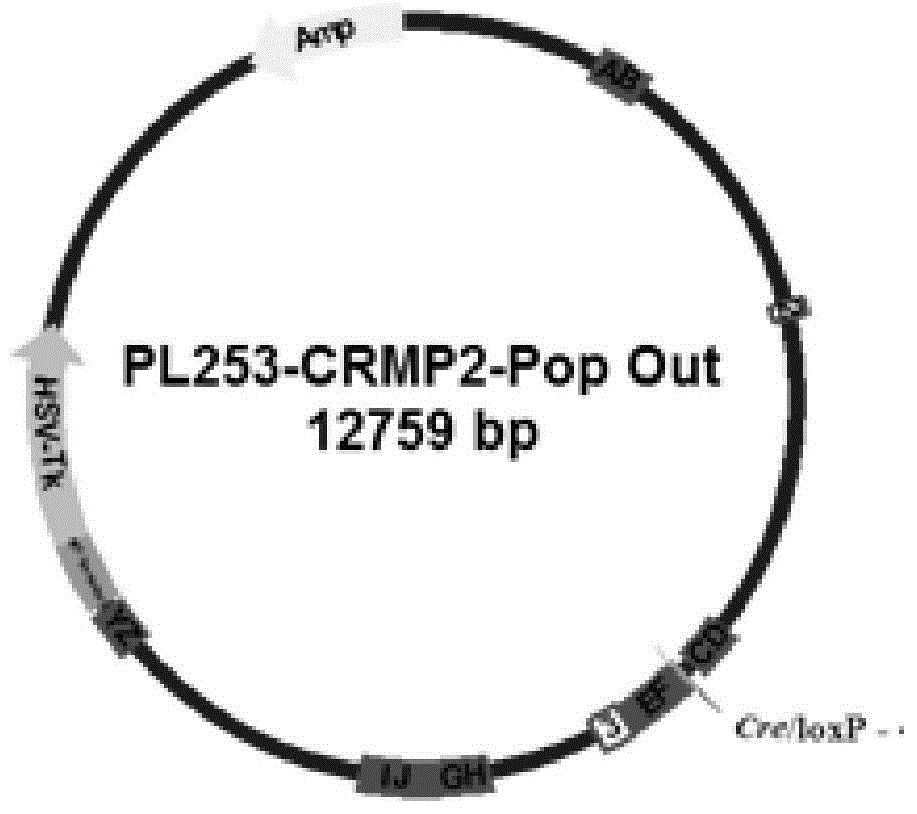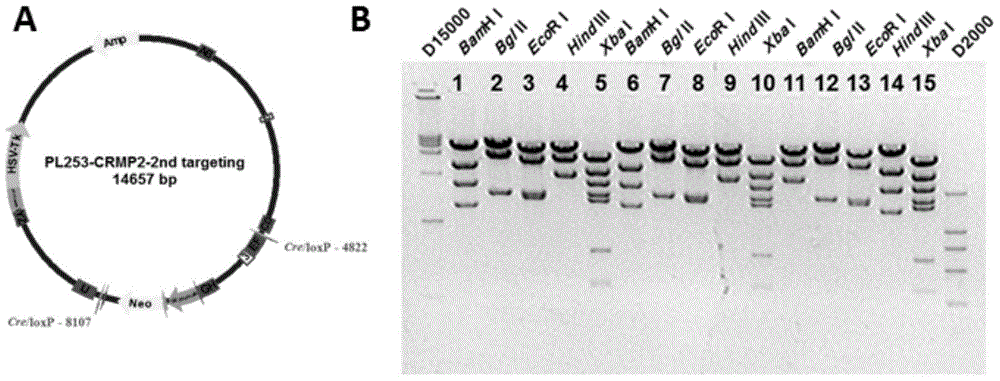Non-human mammal animal model of neurological and psychiatric disease and preparation method and application thereof
A non-human mammal, neuropsychiatric disease technology, applied in animal cells, vertebrate cells, pharmaceutical formulations, etc., can solve the problems of unsatisfactory neuropsychiatric disease animal models and complex causes.
- Summary
- Abstract
- Description
- Claims
- Application Information
AI Technical Summary
Problems solved by technology
Method used
Image
Examples
Embodiment 1
[0160] Example 1 Construction of Targeting Vector
[0161] 1.1 Extraction of mouse BAC DNA
[0162] Streak the BAC (RPCI23-414A17) DH10B bacteria containing the full-length CRMP2 genome on a plate containing chloramphenicol, culture at 37°C for 10 hours, pick 5 single clones, and shake 5 mL of bacteria respectively for 12 hours. 13000rpm, 1min to collect the bacteria, add 300μL P1 (Tris50mM, EDTA10mM, pH8.0) to suspend the bacteria, then add 300μL P2 (0.2M NaOH, 1%SDS), mix well, leave at room temperature for 5min, then add 300μL P3 (3M KAC, pH5.5), shake gently for 2-5min, centrifuge at 10000rpm, 4°C for 10min. Transfer the supernatant to a new EP tube, then add 800 μL of pre-cooled isopropanol, mix upside down and place on ice for 5 minutes, 4°C, 10,000 rpm, 15 minutes, remove the supernatant, wash the precipitate twice with 600 μL of 70% ethanol, and dry in the air , add 40 μL double distilled water, and 1 μL RNaseA, dissolve at 37°C for 30 min.
[0163] 1.2 Preparation ...
Embodiment 2
[0187] Example 2 CRMP2 gene knockout
[0188] 2.1 Gene targeting
[0189] Day 1: Prepare targeting vector, prepare 100mm trophoblast cells
[0190] Target carrier preparation:
[0191] Use NotI to linearize 200 μg of the targeting vector (plasmid extraction method according to QiaGen EndoFree Plasmid Maxi Kit), add twice the volume of absolute ethanol, place at -80°C for 30 minutes, 12000 rpm, 30 minutes, recover by centrifugation, wash twice with 70% ethanol, and dry in the air. Dissolve in 50 μL Milli-Q water.
[0192] Primary mouse fibroblast (MEF) cell recovery culture:
[0193] The cryopreserved MEF cells were taken out from liquid nitrogen, and the MEF feeder layer cells were quickly thawed at 37°C, and the MEF medium was added to a total volume of 10 mL, and the cells were collected by centrifugation at 1000 rpm for 5 min. Resuspend the cells with 10mL MEF medium and plant them on a 100mm Petri dish.
[0194] Day 2: Check trophoblast cells and recover ES cells
[...
Embodiment 3
[0253] The preparation of embodiment 3 animal model
[0254] 3.1 Acquisition of CRMP2 chimeric mice and F1 generation mice
[0255] The identified positive ES cell clones were revived for blastocyst microinjection to inject a total of 90 blastocysts, each embryo was injected with 15 ES cells, and then 90 embryos were transplanted into the uterus of 8 ICR pseudopregnant mother mice. After 19 days, 18 daughter mice were produced, and 10 chimeras survived, of which 6 were male mice, such as Figure 2-6 As shown, only one has a chimerism of about 30%, and the remaining five are all gray. The obtained 6 male mice were mated with C57BL / 6J female mice respectively. Among them, 2 gray mice were infertile, and the other 4 mice were fertile ( Figure 5 ).
[0256] 3.2 Breeding strategy of CRMP2 conditional knockout mice
[0257] The positive CRMP2flox / + born of chimeric male mice mated with C57BL / 6J female mice was defined as the F1 generation. F1 CRMP2flox / + female mice were mate...
PUM
 Login to View More
Login to View More Abstract
Description
Claims
Application Information
 Login to View More
Login to View More - R&D
- Intellectual Property
- Life Sciences
- Materials
- Tech Scout
- Unparalleled Data Quality
- Higher Quality Content
- 60% Fewer Hallucinations
Browse by: Latest US Patents, China's latest patents, Technical Efficacy Thesaurus, Application Domain, Technology Topic, Popular Technical Reports.
© 2025 PatSnap. All rights reserved.Legal|Privacy policy|Modern Slavery Act Transparency Statement|Sitemap|About US| Contact US: help@patsnap.com



